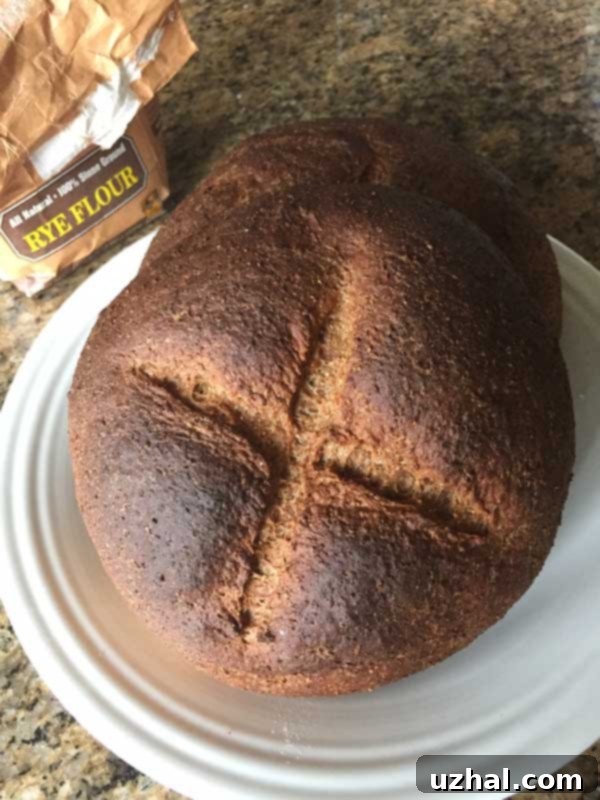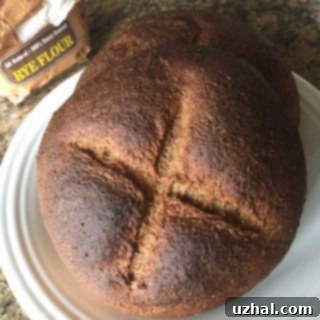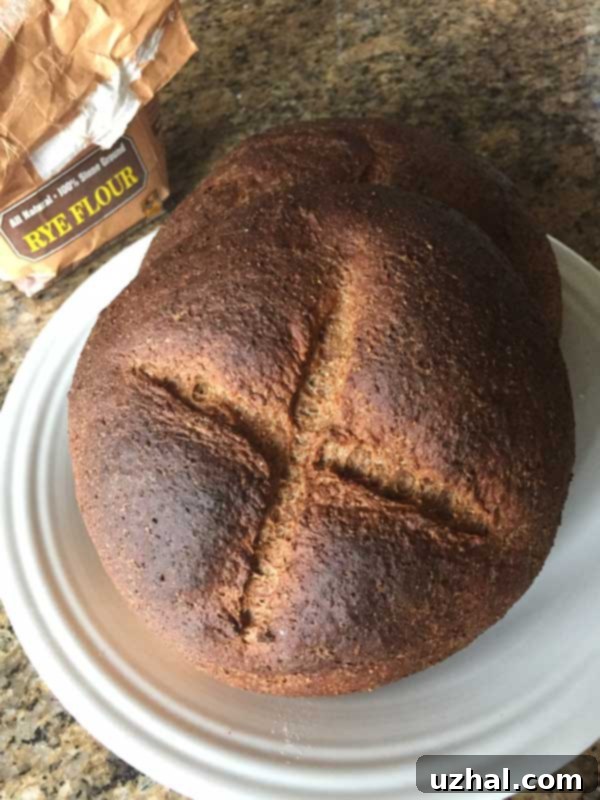Authentic German Dark Rye Bread: A Hearty Homemade Recipe for Robust Flavor
Following the resounding success of my previous Marble Rye creation, which became an instant family favorite, I felt inspired to delve deeper into the rich and rewarding world of rye baking. This culinary journey led me to a decidedly “darker” and even more intensely flavorful bread: the classic German Dark Rye. Baking two beautifully round loaves of this robust bread proved to be a truly satisfying experience, yielding a result that perfectly captured the essence of traditional European baking.
This recipe crafts a bread that embodies all the desirable characteristics of a genuine dark rye. It features a thoughtful blend of earthy rye flour and resilient bread flour, enriched with the distinctive sweetness of molasses, the subtle depth of unsweetened cocoa powder, and the aromatic warmth of caraway seeds. The combination results in a bread with a deep, inviting color, a dense yet tender crumb, and a complex flavor profile that is both comforting and authentically German. It’s an exceptional addition to any meal, from a simple breakfast to a hearty dinner spread.

The Allure of German Dark Rye Bread
German Dark Rye bread, often known as Roggenbrot or Schwarzbrot in Germany, is a staple of European cuisine, cherished for its robust flavor, dense texture, and long shelf life. Unlike lighter rye breads, its deep color and intense taste come from a higher proportion of rye flour, often combined with ingredients like molasses, dark malt, or cocoa powder, which not only contribute to its hue but also add layers of complex sweetness and a slight bitterness that perfectly balances the rye’s characteristic tang. Caraway seeds are a signature addition, imparting a distinctive aromatic quality that is instantly recognizable and deeply traditional.
Historically, rye bread was a fundamental food source in many parts of Europe, particularly in regions where wheat cultivation was challenging due to climate or soil conditions. Rye flour contains less gluten than wheat flour, which is why rye breads tend to be denser and heavier. However, this density also contributes to their incredible keeping qualities and their ability to provide sustained energy. Modern recipes often incorporate some bread flour and vital wheat gluten to achieve a slightly lighter texture and better rise, without sacrificing the rustic charm and nutritional benefits of rye.
The Magic of Key Ingredients
Each ingredient in this German Dark Rye recipe plays a crucial role in developing its unique flavor, texture, and appearance:
- Rye Flour: The star of the show, rye flour provides the signature earthy flavor and dense crumb. It’s naturally lower in gluten than wheat, contributing to the bread’s characteristic texture. Using a quality rye flour, such as Hodgson Mill, ensures a rich and authentic base.
- Bread Flour: Added to balance the rye, bread flour provides stronger gluten development, helping the dough rise and creating a loaf that is less dense than a 100% rye bread. This blend gives the bread a pleasant chewiness while maintaining its rustic integrity.
- Molasses: This dark, sweet syrup is vital for several reasons. It contributes to the bread’s deep, dark color, enhances the flavor with a rich, slightly smoky sweetness, and helps to keep the bread moist, extending its freshness.
- Unsweetened Cocoa Powder: While it might seem unusual for bread, cocoa powder is a secret ingredient in many dark rye recipes. It deepens the bread’s color dramatically without adding a chocolatey flavor. Instead, it subtly enhances the bread’s earthiness and adds a layer of complexity to its overall taste.
- Caraway Seeds: These aromatic seeds are a hallmark of German rye bread. They infuse the loaf with a warm, slightly licorice-like, and peppery flavor that pairs wonderfully with the robust rye. Their inclusion is optional, but highly recommended for an authentic experience.
- Vital Wheat Gluten: Given rye flour’s lower gluten content, vital wheat gluten is an excellent addition to boost the overall gluten structure of the dough. This helps the bread to achieve a better rise and a more open crumb, preventing it from becoming excessively heavy or crumbling too easily.
- Yeast, Sugar, Salt, and Butter: These standard baking ingredients work in harmony to activate the yeast, season the bread, and add richness and tenderness to the final product.
Customizing Your Loaves: Large or Small Batch German Dark Rye Round Loaves
The beauty of this particular German Dark Rye recipe, adapted from the back of the Hodgson Mill Rye Flour bag, lies in its flexibility. You have the option to bake it as two generously sized round loaves, perfect for a larger gathering or for freezing one for later enjoyment. Alternatively, you can easily halve the recipe to yield one large loaf or two more modestly sized round loaves, ideal for serving with an intimate dinner or for smaller households. For my baking session, I chose to create two smaller loaves, finding them to be the perfect portion for accompanying a meal without excess. As you embark on baking, remember that vigilance is key, especially during the final stages, as the bread’s deep color can easily mask the onset of burning.
Other Delicious Rye Flour Recipes to Try
If you’ve enjoyed baking with rye flour, you might be interested in exploring other recipes that showcase its versatility and unique flavor profile. Here are a few favorites:
- Rye Flour Chocolate Chip Cookies
- Dark Chocolate Rye Flour Cookies
- Mary’s Rye Quick Bread
- Caraway and Rye Peanut Butter Cookies
- Dark Rye Bread
Recipe

German Dark Rye
Cookie Madness
Pin Recipe
Ingredients
- 1 cup water warm, between 100-115 degrees F (40-46°C), crucial for activating yeast.
- 2 tablespoons brown sugar to feed the yeast and add a hint of sweetness.
- 1 pkg active dry yeast approximately 2¼ teaspoons.
- 2 tablespoons molasses for deep color, moisture, and rich flavor.
- 1 ¾ cups Hodgson Mill Rye Flour or another high-quality dark rye flour.
- 1 ½ tablespoons unsweetened cocoa powder enhances dark color without adding chocolate taste.
- 1 tablespoon Hodgson Mill Vital Wheat Gluten improves dough elasticity and rise in rye breads.
- ½ to 1 tablespoon Caraway Seeds optional, but highly recommended for traditional German flavor.
- 1 teaspoon salt enhances all the flavors.
- 2 tablespoons butter melted, adds richness and tenderness to the crumb.
- 1 ¼ to 1 ¾ cups bread flour high protein flour for structure.
Instructions
-
Activate the Yeast: In the large bowl of a stand mixer, combine the warm water, brown sugar, and active dry yeast. Stir these ingredients thoroughly with a spoon or whisk until the sugar is dissolved and the yeast is evenly distributed. Allow this mixture to stand undisturbed for approximately 5 minutes. During this time, the yeast should become foamy and bubbly on the surface, indicating it is active and ready to work. If you don’t see bubbles, your water might be too hot or too cold, or your yeast may be old.
-
Combine Wet and Dry Ingredients: To the activated yeast mixture, add the molasses, rye flour, vital wheat gluten, unsweetened cocoa powder, and caraway seeds (if using). Beat all these ingredients together vigorously, either with the paddle attachment of your stand mixer or by hand with a sturdy spoon, until everything is well combined and forms a thick batter. Let this mixture sit for 10 minutes. This resting period, known as autolyse, allows the flours to fully hydrate. After resting, mix in the melted butter and salt until fully incorporated.
-
Knead the Dough: Gradually add 1 cup of the bread flour to the mixture and stir until it’s well blended. Continue adding the remaining bread flour gradually, a quarter cup at a time, stirring until you achieve a soft, manageable dough. The exact amount of bread flour needed can vary depending on humidity and flour type, so add just enough to form a dough that pulls away from the sides of the bowl but is still slightly sticky. Switch to the dough hook attachment on your stand mixer and knead the dough for 8 to 10 minutes on medium-low speed. The dough should become smooth and elastic. If kneading by hand, turn the dough out onto a lightly floured surface and knead for 12-15 minutes until it passes the windowpane test (a small piece can be stretched thin enough to see light through it without tearing). Transfer the kneaded dough to a lightly oiled bowl, turning once to coat, then cover with plastic wrap or a clean kitchen towel. Let it rise in a warm, draft-free place for 1 hour, or until it has roughly doubled in size.
-
Shape and Second Rise: Gently punch down the risen dough to release the air. If making two smaller loaves, divide the dough into two equal pieces. If you prefer one large loaf, keep it as a single piece. Shape each piece into a smooth, round ball. For best results and easy handling, place the shaped loaves side-by-side (or a single loaf by itself) on a baking sheet lined with parchment paper. This prevents sticking and makes transfer easier. Cover the loaves loosely; overturned mixing bowls are an excellent way to create a humid environment for the second rise without sticking to the dough. Let them rise again for another hour in a warm spot, or until they look noticeably puffy and have increased in volume.
-
Preheat Oven: Approximately 15-20 minutes before the second rise is complete, preheat your oven to 450 degrees F (232°C). This ensures the oven is at the correct temperature for the best initial oven spring when the bread goes in.
-
Bake the Loaves: Carefully transfer the baking sheet to the preheated oven. Bake the two smaller loaves for about 20 minutes. If you are baking one large loaf, it will require approximately 25 minutes. Keep a close eye on the bread as it bakes, especially towards the end, as the dark color of the rye can make it difficult to tell if it’s getting too brown or burning on top. If the crust starts to darken too quickly, loosely tent the loaves with aluminum foil. To accurately test for doneness, insert a meat thermometer into the center of a loaf; it should register at least 205 F (96°C). Another indicator is tapping the bottom of the loaf – it should sound hollow. Once baked, remove the loaves from the oven and transfer them to a wire rack to cool completely. This cooling process is crucial for the bread’s texture and flavor to fully develop.
Serving Suggestions for German Dark Rye Bread
Once your German Dark Rye bread has cooled completely, it’s ready to be enjoyed in a myriad of ways. Its hearty texture and rich flavor make it incredibly versatile. It’s a fantastic base for open-faced sandwiches, topped with anything from thinly sliced deli meats and cheeses to smoked salmon and cream cheese. Traditional German pairings include strong cheeses, cured sausages like salami or pastrami, and pickled vegetables. For a simpler pleasure, enjoy it toasted with a smear of butter or your favorite jam. Its robust profile also makes it an excellent accompaniment to hearty soups, stews, and chilis, where it can be used to soak up flavorful broths. Don’t shy away from serving it alongside a fresh salad, as its distinct taste provides a wonderful contrast.
Storage Tips to Keep Your Rye Bread Fresh
German Dark Rye bread is known for its excellent keeping qualities. To maintain its freshness and prevent it from drying out, store it properly. For short-term storage (2-3 days), wrap the cooled loaf tightly in plastic wrap or aluminum foil, or place it in a bread box at room temperature. Avoid refrigerating bread, as it tends to dry out faster. For longer storage, slices or whole loaves can be frozen. Wrap individual slices or the entire loaf tightly in plastic wrap, then place it in a freezer-safe bag. When ready to enjoy, simply thaw at room temperature or toast slices directly from frozen. This method helps preserve its texture and flavor for up to several months.
Conclusion: Embrace the Richness of Homemade Rye
Baking German Dark Rye bread at home is a rewarding experience that connects you with a rich culinary tradition. The deep flavors of rye, molasses, cocoa, and caraway come together to create a loaf that is truly satisfying, whether it’s the star of your sandwich or a humble accompaniment to your meal. This recipe offers a straightforward path to achieving an authentic, flavorful bread that will impress your family and friends. So, gather your ingredients, follow these steps, and prepare to enjoy the wholesome, hearty goodness of homemade German Dark Rye bread. Happy baking!
